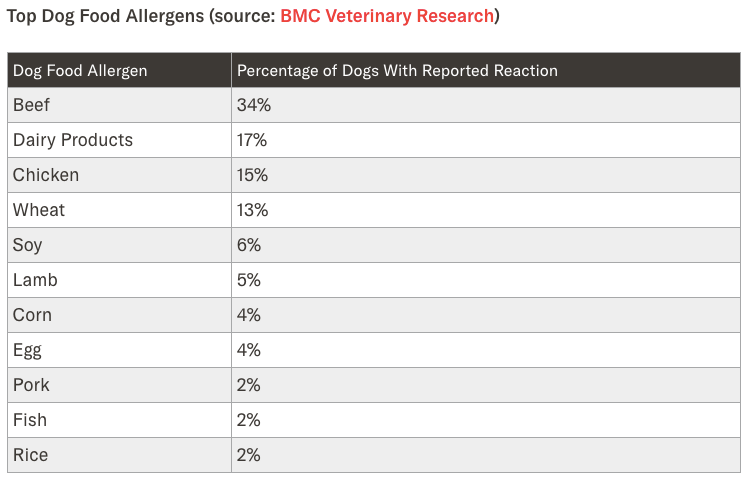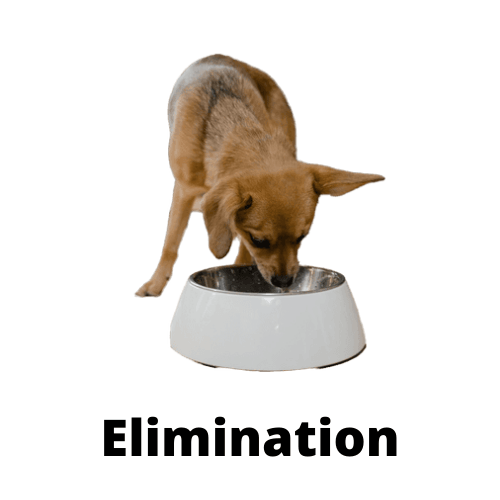
As dog owners, we want the very best for our four-legged companions. They give us so much, and when our pet is not feeling well, it is cause for concern. A common, but unfortunate health issue that some dogs suffer through pertains to their diet and what is being consumed. In short, your dog may be suffering from or allergic to a specific type of ingredient. Having a dog with food allergies is no laughing matter to dog owners.
In this article, we will take a look at and define food allergies, and symptoms associated with this. We will also examine causes and/or triggers, and what can be done to alleviate this problem. We will also take a look at products that may be beneficial to dog owners faced with this issue. Let’s get started:
Food Allergies With Dogs … What’s This All About?
For this article we will concentrate on the food allergy in dogs. Just like us, there are certain foods that dogs have a difficult time in tolerating. Think about how some of us just can’t be anywhere near a peanut! This same type of allergic reaction can be seen in dogs with the consumption of a specific ingredient(s). In addition, there are other types of allergies that can be harmful to our four-legged companions. Skin allergies and environmental allergens can impact the health of our pets as well. 
So what causes this food allergy with dogs? To answer this question we need only to take a look at our dog’s immune system. A canine’s immune system will fight off anything (germs) that may be detrimental to them. When your pet has encounters a food allergy, the immune system will mistake their food as something harmful. The pet’s immune system will then go on the attack. To simplify this, the immune system overreacts causing discomfort in your pet.
Dog With Food Allergies … Symptoms You May Notice
Oh, the dreaded food allergies! Unfortunately, if your dog displays one or a few of these symptoms listed below, a food allergy is possible. Here are a number of things you may be noticing with your pet:
- Diarrhea
- Itchiness, Scratching
- Vomiting
- Ear and Skin Infections
- Scooting
- Excessive gas
- Licking
- Hot Spots
- Sneezing
None of these symptoms are ones that you, as the dog owner, should take lightly. In no way is this an inclusive list, but it does give you some guidelines to be aware of. If you notice one, or a combination of these symptoms, it would be wise to see your local veterinarian. You and your vet can work together to determine if your pet is suffering from a food allergy.
What Causes or Triggers This Food Allergy In Dogs?
Well, we have already discussed the immune system and why it is the culprit when it comes to dog food allergies. But what is it that causes this system to react this way? According to Dr. Justin Shmalberg, a DVM, “the culprit is often a food protein that triggers an adverse immune response. This causes cells in the body to release histamines or compounds that lead to itching and many other allergic signs.”
To put things in perspective, let’s take a look at the allergens causing discomfort according to the BMC Veterinary Research:

Most dog products will include one or more of the ingredients listed above, so you can see that eliminating the culprit can be a daunting task. That is why it is so important to consult your vet who will be able to administer a number of tests that hopefully will determine which ingredient is the culprit.
Dog Food Allergy … What Can I Do To Help My Best Buddy?
If you see symptoms with your pet that look odd or out of place, consult your local veterinarian. This should be your first step in getting your pet the help it needs to resolve this issue. Your vet may recommend an elimination diet trial, which will help determine which ingredient your pet may be allergic.
veterinarian. This should be your first step in getting your pet the help it needs to resolve this issue. Your vet may recommend an elimination diet trial, which will help determine which ingredient your pet may be allergic.
The elimination diet or the dog food allergies test is one that can be complex, and one that may try your patience as a dog owner. In its simplest form, the elimination diet is one of well, elimination. This is accomplished by slowly removing the most common allergens (carbohydrates and proteins). We will eventually get to a point where all or most of the common allergens are eliminated.
When this has been accomplished, it’s now time to re-introduce these common allergens (in most cases, one at a time) and then take notice of your dog’s behavior. Did the re-introduction to beef cause a reaction? Chicken? Dairy Product? If so, you may have pinpointed which dog food allergen is the culprit. This entire process may take months to complete, but finding and identifying the allergen is worth it. To be clear, there is nothing you as a dog owner can do until the allergen or culprit causing this discomfort is eliminated.
Okay, we have devised a plan to help our pooch with this nasty food allergy, but what do feed them? Let’s take a look at a couple of diets that you may or may not be familiar with.
What Are The Hypoallergenic and Limited-Ingredient Diets?
Hypoallergenic – This type of diet is one that your veterinarian will likely prescribe if it is determined that your pet is suffering from a dog food allergy. In its simplest form, a hypoallergenic diet is one that excludes many of the common allergens that are listed in the chart above. Ingredients like beef, chicken, dairy products, wheat, etc. are absent from the recipe.
In addition, the hypoallergenic dog food goes thru a process that breaks down possible allergens (proteins) on a molecular level. This process, known as hydrolyzed, makes it difficult for your pooch to recognize this protein, and thus eliminates a reaction in your pooch. Here is a short video to better illustrate this type of diet.
Limited-Ingredient – The limited-ingredient diet is one that contains just what it says, limited ingredients. This is of importance as it becomes easier to identify which ingredient may be causing the allergy in your dog. There are a number of Limited-Ingredient brands on the market today that you can purchase if you choose to identify the ingredient culprit yourself.
If you decide to go with this diet, just be sure to read the ingredient list on the back of the bag. There could be some ingredients listed towards the bottom that may still be a common allergen. Limited ingredient recipes are not regulated in terms of how many ingredients they may contain, it will just have fewer than the ‘regular’ dog food recipes. One very popular limited ingredient is one of the Blue Buffalo recipes. You can find this recipe by clicking HERE.
Final Thoughts
Well, there you have it. Look, none of us want to see our furry friends to be in discomfort and having a dog with food allergies can be stressful. I truly hope this article will be helpful for those encountering this issue. We have discussed such things as symptoms, causes, how to get assistance, and a couple of diets that may be beneficial to your pet.
As mentioned earlier, it has always been my belief that consulting with your local vet should be your first step if you notice that your pet is behaving differently. Without this consultation, you may not know if your pet is suffering from a food allergy or something else entirely. I wish you and your pet the very best!
Note: This article contains affiliate links and offers, and I may receive a commission if you decide to purchase one of these products.
Disclaimer
For those unfamiliar with dog food grain-free recipes, there has and is a controversy taking place as I write this article. The FDA has made public that it has launched an investigation between a possible connection between the grain-free diet and heart disease within dogs. For further information, the American Kennel Club has provided further details. Click here.
Disclaimer
The purpose of this site and articles are intended to provide a source of entertainment and information. As a dog owner and dog lover myself, I enjoy researching dog food products on the market to provide you with helpful insights. I am not a veterinarian nor an animal nutritionist, just a dog owner who wants to provide a healthy lifestyle to their pet. I use my research to express an opinion which may or may not be one you agree with.
0 Comments